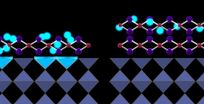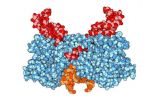(Press-News.org) Menlo Park, Calif. -- A study at the Department of Energy's SLAC National Accelerator Laboratory suggests for the first time how scientists might deliberately engineer superconductors that work at higher temperatures.
In their report, a team led by SLAC and Stanford University researchers explains why a thin layer of iron selenide superconducts -- carries electricity with 100 percent efficiency -- at much higher temperatures when placed atop another material, which is called STO for its main ingredients strontium, titanium and oxygen.
These findings, described today in the journal Nature, open a new chapter in the 30-year quest to develop superconductors that operate at room temperature, which could revolutionize society by making virtually everything that runs on electricity much more efficient. Although today's high-temperature superconductors operate at much warmer temperatures than conventional superconductors do, they still work only when chilled to minus 135 degrees Celsius or below.
In the new study, the scientists concluded that natural trillion-times-per-second vibrations in the STO travel up into the iron selenide film in distinct packets, like volleys of water droplets shaken off by a wet dog. These vibrations give electrons the energy they need to pair up and superconduct at higher temperatures than they would on their own.
"Our simulations indicate that this approach - using natural vibrations in one material to boost superconductivity in another - could be used to raise the operating temperature of iron-based superconductors by at least 50 percent," said Zhi-Xun Shen, a professor at SLAC and Stanford University and senior author of the study.
While that's still nowhere close to room temperature, he added, "We now have the first example of a mechanism that could be used to engineer high-temperature superconductors with atom-by-atom control and make them better."
Spying on Electrons
The study probed a happy combination of materials developed two years ago by scientists in China. They discovered that when a single layer of iron selenide film is placed atop STO, its maximum superconducting temperature shoots up from 8 degrees to nearly 77 degrees above absolute zero (minus 196 degrees Celsius).
While this was a huge and welcome leap, it would be hard to build on this advance without understanding what, exactly, was going on.
In the new study, SLAC Staff Scientist Rob Moore and Stanford graduate student J.J. Lee and postdoctoral researcher Felix Schmitt built a system for growing iron selenide films just one layer thick on a base of STO.
The team examined the combined material at SLAC's Stanford Synchrotron Radiation Lightsource, a DOE Office of Science User Facility. They used an exquisitely sensitive technique called ARPES to measure the energies and momenta of electrons ejected from samples hit with X-ray light. This tells scientists how the electrons inside the sample are behaving; in superconductors they pair up to conduct electricity without resistance. The researchers also got help from theorists who did simulations to help explain what they were seeing.
A Promising New Direction
"This is a very impressive experiment, one that would have been very difficult to impossible to do anywhere else," said Andrew Millis, a theoretical condensed matter physicist at Columbia University, who was not involved in the study. "And it's clearly telling us something important about why putting one thin layer of iron selenide on this substrate, which everyone thought was inert and boring, changes things so dramatically. It opens lots of interesting questions, and it will definitely stimulate a lot of research."
Scientists still don't know what holds electron pairs together so they can effortlessly carry current in high-temperature superconductors. With no way to deliberately invent new high-temperature superconductors or improve old ones, progress has been slow.
The new results "point to a new direction that people have not considered before," Moore said. "They have the potential to really break records in high-temperature superconductivity and give us a new understanding of things we've been struggling with for years."
He added that SLAC is developing a new X-ray beamline at SSRL with a more advanced ARPES system to create and study these and other exotic materials. "This paper predicts a new pathway to engineering superconductivity in these materials," Moore said, "and we're building the tools to do just that."
INFORMATION:
In addition to researchers from SLAC's Materials Science Division and from Stanford, scientists from the University of British Columbia, the University of Tennessee, Lawrence Berkeley National Laboratory and the University of California, Berkeley contributed to this study. The work was funded by the DOE Office of Science.
SLAC is a multi-program laboratory exploring frontier questions in photon science, astrophysics, particle physics and accelerator research. Located in Menlo Park, California, SLAC is operated by Stanford University for the U.S. Department of Energy Office of Science. To learn more, please visit http://www.slac.stanford.edu.
SLAC National Accelerator Laboratory is supported by the Office of Science of the U.S. Department of Energy. The Office of Science is the single largest supporter of basic research in the physical sciences in the United States, and is working to address some of the most pressing challenges of our time. For more information, please visit science.energy.gov.
Graphene is the miracle material of the future. Consisting of a single layer of carbon atoms arranged in a honeycomb lattice, the material is extremely stable, flexible, highly conductive and of particular interest for electronic applications. ETH Professor Tilman Esslinger and his group at the Institute for Quantum Electronics investigate artificial graphene; its honeycomb structure consists not of atoms, but rather of light. The researchers align multiple laser beams in such a way that they create standing waves with a hexagonal pattern. This optical lattice is then superimposed ...
A research team led by Jackson Laboratory Professors Frank McKeon, Ph.D., and Wa Xian, Ph.D., reports on the role of certain lung stem cells in regenerating lungs damaged by disease.
The work, published Nov. 12 in the journal Nature, sheds light on the inner workings of the still-emerging concept of lung regeneration and points to potential therapeutic strategies that harness these lung stem cells.
"The idea that the lung can regenerate has been slow to take hold in the biomedical research community," McKeon says, "in part because of the steady decline that is seen ...
The brain's ability to effectively deal with stress or to lack that ability and be more susceptible to depression, depends on a single protein type in each person's brain, according to a study conducted at the Icahn School of Medicine at Mount Sinai and published November 12 in the journal Nature.
The Mount Sinai study findings challenge the current thinking about depression and the drugs currently used to treat the disorder.
"Our findings are distinct from serotonin and other neurotransmitters previously implicated in depression or resilience against it," says the ...
Not long ago, it would have taken several years to run a high-resolution simulation on a global climate model. But using some of the most powerful supercomputers now available, Lawrence Berkeley National Laboratory (Berkeley Lab) climate scientist Michael Wehner was able to complete a run in just three months.
What he found was that not only were the simulations much closer to actual observations, but the high-resolution models were far better at reproducing intense storms, such as hurricanes and cyclones. The study, "The effect of horizontal resolution on simulation ...
The human immunodeficiency virus (HIV) can insert itself at different locations in the DNA of its human host - and this specific integration site determines how quickly the disease progresses, report researchers at KU Leuven's Laboratory for Molecular Virology and Gene Therapy. The study was published online today in the journal Cell Host & Microbe.
When HIV enters the bloodstream, virus particles bind to and invade human immune cells. HIV then reprogrammes the hijacked cell to make new HIV particles.
The HIV protein integrase plays a key role in this process: it ...
Details of the role of glutamate, the brain's excitatory chemical, in a drug reward pathway have been identified for the first time.
This discovery in rodents - published today in Nature Communications - shows that stimulation of glutamate neurons in a specific brain region (the dorsal raphe nucleus) leads to activation of dopamine-containing neurons in the brain's reward circuit (dopamine reward system).
Dopamine is a neurotransmitter present in regions of the brain that regulate movement, emotion, motivation, and feelings of pleasure. Glutamate is a neurotransmitter ...
HANOVER, N.H. - China's anti-logging, conservation and ecotourism policies are accelerating the loss of old-growth forests in one of the world's most ecologically fragile places, according to studies led by a Dartmouth College scientist.
The findings shed new light on the complex interactions between China's development and conservation policies and their impact on the most diverse temperate forests in the world, in "Shangri-La" in northwest Yunnan Province. Shangri-La, until recently an isolated Himalayan hinterland, is now the epicenter of China's struggle to wed sustainable ...
The "surfactant" chemicals found in samples of fracking fluid collected in five states were no more toxic than substances commonly found in homes, according to a first-of-its-kind analysis by researchers at the University of Colorado Boulder.
Fracking fluid is largely comprised of water and sand, but oil and gas companies also add a variety of other chemicals, including anti-bacterial agents, corrosion inhibitors and surfactants. Surfactants reduce the surface tension between water and oil, allowing for more oil to be extracted from porous rock underground.
In a new ...
Action movies may drive box office revenues, but dramas and deeper, more serious movies earn audience acclaim and appreciation, according to a team of researchers.
"Most people think that entertainment is just a silly diversion, but our research shows that entertainment is profoundly meaningful and moving for many people," said Mary Beth Oliver, Distinguished Professor in Media Studies and co-director of Media Effects Research Laboratory, Penn State. "It's not just types of entertainment that we usually think of as meaningful, such as poetry and dance, either, but also ...
Shark populations in the Mediterranean are highly divided, an international team of scientists, led by Dr Andrew Griffiths of the University of Bristol, has shown. Many previous studies on sharks suggest they move over large distances. But catsharks in the Mediterranean Sea appear to move and migrate much less, as revealed by this study. This could have important implications for conserving and managing sharks more widely, suggesting they may be more vulnerable to over-fishing than previously thought.
The study, published in the new journal Royal Society Open Science, ...





